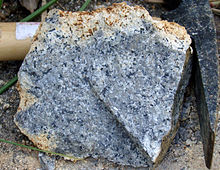Nepheline syenite
This article includes a list of general references, but it lacks sufficient corresponding inline citations. (February 2014) |
| Secondary | magnetite, ilmenite, apatite, titanite |
|---|---|
Nepheline syenite is a
Petrology

Nepheline syenites are silica-undersaturated and some are
They are distinguished from
Macroscopic aspects

Macroscopic aspects of nepheline syenite are similar to those of
Texture
The rock is holocrystalline, generally
Mineral composition
The main minerals are
The alkaline feldspar is not potassic, but generally sodic-potassic, which is characterized by interlocking
The accessory minerals are
Genesis
Silica-undersaturated igneous rocks typically are formed by low degrees of partial melting in the Earth's mantle. Carbon dioxide may dominate over water in source regions. Magmas of such rocks are formed in a variety of environments, including continental rifts, ocean islands, and supra-subduction positions in subduction zones. Nepheline syenite and phonolite may be derived by crystal fractionation from more mafic silica-undersaturated mantle-derived melts, or as partial melts of such rocks. Igneous rocks with nepheline in their normative mineralogy commonly are associated with other unusual igneous rocks such as carbonatite.
Distribution

Nepheline syenites and phonolites occur, for example, in
Phonolite lavas formed in the East African rift in particularly large quantity, and the volume there may exceed the volume of all other phonolite occurrences combined, as discussed by Barker (1983).
Nepheline-normative rocks occur in close association with the
Nepheline syenites are rare; there is only one occurrence in Great Britain (Loch Borralan)[3] and one in France and Portugal. They are known also in Bohemia and in several places in Norway, Sweden and Finland. In the Americas these rocks have been found in Texas, Arkansas, New Jersey (Beemerville Complex[4]) and Massachusetts, also in Ontario, British Columbia and Brazil. South Africa, Madagascar, India, Tasmania, Timor and Turkestan are other localities for the rocks of this series.
Rocks of this class also occur in
Nomenclature
There is a wide variety of silica-undersaturated and peralkaline igneous rocks, including many informal place-name varieties named after the locations in which they were first discovered. In many cases these are plain nepheline syenites containing one or more rare minerals or mineraloids, which do not warrant a new formal classification. These include;
Foyaite: foyaites are named after Foya in the Serra de Monchique, in southern Portugal. These are K-feldspar-nepheline syenites containing <10% ferromagnesian minerals, usually pyroxene, hornblende and biotite.
Laurdalite: The laurdalites, from Laurdal in Norway, are grey or pinkish, and in many ways closely resemble the larvikites of southern Norway, with which they occur. They contain anorthoclase feldspars, biotite or greenish augite, much apatite and in some cases, olivine.
Ditroite: Ditroite derives its name from Ditrau,
Chemical composition

The chemical peculiarities of the nepheline-syenites are well marked. They are exceedingly rich in
are never present in great quantity, though somewhat more variable than the other components. A worldwide average of the major elements in nepheline syenite tabulated by Barker (1983) is listed below, expressed as weight percent oxides.Nepheline syenite is characterized by high ratio of (Na2O+K2O)/SiO2 and (Na2O+K2O)/Al2O3, which are represented respectively by the existence of nepheline and alkaline
- SiO2: 54.99%
- TiO2: 0.60%
- Al2O3: 20.96%
- Fe2O3: 2.25%
- FeO: 2.05%
- MnO: 0.15%
- MgO: 0.77%
- CaO: 2.31%
- Na2O: 8.23%
- K2O: 5.58%
- H2O: 1.47%
- P2O5: 0.13%
The normative mineralogy of this average composition contains about 22% nepheline and 66% feldspar.
Because nepheline syenite lacks quartz and is rich in feldspar and nepheline, it is used in the manufacturing of glass and ceramics.
Applications
Industrial use of nepheline syenite includes refractories,
Requirements for nepheline syenite as a raw material for glass manufacturer include:[6]
- Al2O3 >23%; >14% Na2O + K2O; Fe2O3 <0.1%,
- Absence of refractory minerals.
- Coarsely ground, typically -40# to +200# mesh.
The typical mineralogical and chemical analysis of a ceramic grade nepheline syenite are:[7]
| Country | Norway |
|---|---|
| Producing company | Sibelco |
| Albite, % | 11 |
| Microcline, % | 48.5 |
| Analcime, % | 0.6 |
| Nepheline , % | 39.8 |
| SiO2, % | 55.7 |
| Al2O3, % | 24.5 |
| Fe2O3, % | 0.1 |
| TiO2, % | - |
| CaO, % | 1.1 |
| MgO, % | - |
| K2O, % | 8.8 |
| Na2O, % | 8.2 |
| LOI, % | - |
Notes
- S2CID 135266142.
- ^ S. W. Wallace (1953). The petrology of the Judith Mountains, Fergus County, Montana (Report). U.S. Geological Survey.
- ^ Sutherland, D.S. (editor) (1982) Igneous Rocks of the British Isles, page 211
- Shawnee on Delaware, PA, p. 85–91.
- Industrial Minerals, Pg. 268
- ^ ’Industrial Minerals And Their Uses - A Handbook And Formular’ P. A. Ciullo. William Andrew, 1996. Pg. 43
- ^ "Nepheline Syenite – Improve the Functional and Aesthetic Characteristics of Matt Glazes" (PDF). Sibelco. Retrieved 11 April 2023.
References
- Sørensen, H. 1974. The alkaline rocks. 1st Edition. John Wiley & Sons Ltd. 634 p. ISBN 0-471-81383-4.
- Streckeisen, A. L. 1978. IUGS Subcommission on the Systematics of Igneous Rocks. Classification and Nomenclature of Volcanic Rocks, Lamprophyres, Carbonatites and Melilite Rocks. Recommendations and Suggestions. Neues Jahrbuch für Mineralogie, Abhandlungen, 141, 1–14.
- Motoki, A., Sichel, S. E., Vargas, T., Aires, J. R., Iwanuch, W., Mello, S. L. M., Motoki, K. F., Silva, S., Balmant, A., Gonçalves, J. 2010. Geochemical evolution of the felsic alkaline rocks of Tanguá, Rio Bonito, and Itaúna intrusive bodies, State of Rio de Janeiro, Brazil. Geociências, Rio Claro, 29–3, 291–310.
- Motoki, A., Araújo, A. L., Sichel, S. E., Motoki, K. F., Silva, S. Nepheline syenite magma differentiation process by continental crustal assimilation for the Cabo Frio Island intrusive complex, State of Rio de Janeiro, Brazil. Geociências, Rio Claro, 2011, in press.
- Attribution
- This article incorporates text from a publication now in the (11th ed.). Cambridge University Press.
Further reading
- Daniel S. Barker, Igneous Rocks, Prentice-Hall, Inc., 417 p., 1983. ISBN 0-13-450692-8
